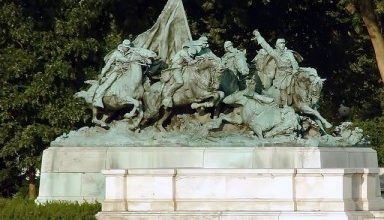The short story “The Shrinking Shoe” was published in 1895 in the monthly edition of The Pall Mall Magazine revolving around the lives of Katie and Geoffrey, two individuals who are poles apart in their aspirations but destiny opts to connect them through the sensitive thread of honesty and love. It also explores the proportionality between time, money and ambition that ultimately defined a man’s worth and character in Victorian society.
Sir Walter Besant was an English novelist whose diverse scholarly interests led to his establishment as Britain’s great literary figure during the late Victorian era.
The Shrinking Shoe | Summary
The story commences with a young seventeen-year-old girl Katie lamenting over the loss of her chance to attend the ball to which only her elder sisters are invited. She imagines the ball with beautiful women and men dancing to delightful music leading her to grow restless. Her apprehension about the arrival of the fairy godmother to her rescue with a stunning dress and the pumpkin chariot with the mice alludes to the popular tale of Cinderella. Soon, as she resorts to sleeping, a knock astonishes her and her vision comes alive. Her godmother is waiting for her with all the arrangements and Katie reaches the venue. But a twist in modern-day Cinderella awaits her as instead of the prince, a young man of twenty from a humble background named Geoffrey approaches her.
There is an instant spark between them and the entire evening goes by talking to each other. Geoffrey falls in Katie’s charms and discloses his ambition- a secret a man should hold dearly to himself otherwise. He aspires to become a statesman despite the lack of any political influence and economic resources. However, she is impressed by his choice of profession and hopes for his success. She even suggests he venture into poetry and excel in both fields. After two days, Geoffrey sends a pair of glass shoes to Katie’s house which the sisters assume to be an act by the prince who is too shy to call her.
The story shifts to a time-lapse of five years where Geoffrey is now a baronet who s enjoying the inheritance of his dead cousin. He is free from the responsibilities of his family as the sole earning member and kills his time doing nothing productive or worthy. Horace, Katie’s cousin is friends with him and advises him to utilise his time and work on the goals he set years ago. Geoffrey dispels all his efforts as he acknowledges that money and pleasure have become his weakness and he couldn’t let go of them even if he attempts to. Suddenly, his glance captures a picture on Horace’s cabinet- a beautiful girl who he tries to recall. Horace reveals it to be Katie and spills on her fantasies and Geoffrey finds himself in quick flashbacks. He remembers her and reads a poem composed by her on the back of the picture. She captures her long years of waiting for her prince and her trust in his capabilities in the few lines.
Geoffrey flushes with embarrassment and shame. He decides to leave Horace’s premises and go back to his place where other people from the profession of amusement shall be waiting for him. After the night of games and drinks, he contemplates his life and realises its downfall. There is a powerful introspection by him as he holds himself responsible for Katie’s state- a woman who believed in him when no one might have and still counts on for his arrival.
He reaches the countryside the next day in order to meet his angel lady and confess his failure. Katie is overwhelmed to see her prince who does not just fall to her knees and hold her hands to express the joy of meeting her. Instead, he just politely addresses her and they fix a meeting for tea the following afternoon. Geoffrey, wasting no time further reveals to her the loss of ambition and his lust for pleasure and money, disheartening Katie and brutally shattering her hopes. Her disappointment adopts an emotionless voice towards the man she loved. Geoffrey accepts his faults and apologises to her but before leaving, insists on looking at the glass shoes he sent five years ago. Katie presents them to him and claims the shoes to have shrunken as they do not fit her anymore. Their deteriorating condition also pains her. Geoffrey asks Katie to give him another chance to redeem himself and make up for the lost time. He wishes to expand the shoes once again in order for her to fit in perfectly, symbolising his efforts to work towards the ambitions he held in the past to become a suitable life partner for her. Katie, now a woman who would not be deceived by any false promises demands him to visit her next time only if he succeeds in achieving his goals. Geoffrey with a less enthusiastic approach assures her and they bid farewell.
The Shrinking Shoe | Analysis
The story is penned with a first-person narrator who often engages with the readers directly. He alerts the readers and warns them of any misinterpretation by stating for instance his support for Katie’s remorse- “Mind you, she had very good cause to cry” or reminds the readers about the character he has already introduced to spare him the trouble of doing that all over again- “Sir Geoffrey Armiger, a young man whom you have already met.” He regularly breaks the fourth wall.
The text is divided into sections to enable a smooth flow of the plotline. The tone is fairly contemplative and self-reflexive as the narrator frequently creates a space for his comments on a particular episode. The story is at times melodramatic too like in Katie’s “tear just showing in either eye, but not rolling down her cheek.” The entire is premised on an allusion to the popular fairytale romance Cinderella with multiple twists and turns to build an alternate story on the concerning trope. The narrative’s preoccupation with marriages, ball dances, money, and power is quite evident in its characterisation.
Women like Katie and her elder sisters are quite different in their approaches to life. While the latter opt to focus on their looks while going to the ball, the former believes that “beauty was entirely a matter of dress; and that, except on state occasions, no one should think of beauty—i.e., of fine dress.” The victorian era is famous for its conduct literature which teaches women about expected mannerisms in society. Katie abides and refutes them at the same time. As a true Victorian woman, she is a simple and soft-spoken woman who becomes a nursing maid for the sick later on as a selfless serving woman. But she rejects many great men who ask her hand for marriage as she still waits for her prince charming. Living a life of a hopeless romantic lacks support by conducting books.
The title of the story is interesting in its symbolism of the glass shoe as both a fragile object and an object of hope and promise. Geoffrey gifts Katie a pair of glass shoes as a token of his affection towards her and a reassurance of his promises. However, over time, the shoe grows smaller as Katie claims. In effect, it is literally not possible for a shoe to size down. Instead, it metaphorically refers to the sizing down of Geoffrey’s ambitions and promises. Katie takes care of the shoe as a beloved possession which also represents her lingering hope. While the glass object stays intact, Katie’s hopes do shatter into million pieces. The beautiful glass shoe as Geoffrey exclaims was a pretty thing “then, wasn’t it? A world of promise in it, I remember. Hope, courage, and—and all kinds of possibilities. Pity—silver gone black, pearls tarnished, colour faded, the thing itself shrunken.” Towards the end of the story, he wishes to “burnish up that silver, expand the shrinking shoe, renew those dreams.” But Katie is smart enough to not fall for any false promises the second time. She clearly demands his next appearance only when Geoffrey does achieve his goal.
The story does not offer much in terms of plot action. It is a straightforward story exposing the old-time debate between reality and imagination, both of them deceiving a human equally.
The Shrinking Shoe | Themes
AMBITION – The story centralises Ambition as a key theme- its inspiration and the subsequent downfall. Like any young man, Geoffrey to aspires to enter a profession which men from his family would not otherwise conceive an idea of or even consider due to limitations on connections and monetary resources. However, setting up an aim for oneself proclaims hard work and a fight against all the barriers. Giving up should never be an option. But men like Geoffrey forget their goals once they acquaint themselves with the relishes of money and entertainment. They corrode the healthy minds of young men and spoil them for no good. Thus, one should never leave the path of their goals and dreams and even though money and power attach themselves, the wise use of them is advised.
ROMANCE – Victorian era was characterised by love, dance balls, charming affairs and marriages. It has produced some of the great romances literature treasures today. Romance surfaces in almost every text written during the age so it couldn’t escape this story as well. Katie is a romantic at heart who lives in a fantasy world of prince charming and debutante balls. Life for her seems like an enactment of a novel. But she is deceived by her hopeful romanticism as the man she dreams of for five years does turn up the way she imagines and he promised to be. As a rose which is accompanied by thorns, romance has its own pitfalls.
WORK V/S PLEASURE – There are characters in the story who work hard to carve out an identity and purpose for themselves in this world while others simply opt to revel in the riches passed onto them by a dead man. The corrupting influence of money taints Geoffrey’s noble aspirations to become a statesman. He turns into a professor of amusement who just kills time. Surprisingly, Katie lives a selfless life working for the sick in the countryside-untarnished by the corroding forces of money and pleasure. She religiously looks after her patients and actually establishes an identity for herself as a nursing maid, unlike Geoffrey who made large promises to her the day they met five years before. Words aren’t enough. Actions affirm your character which clearly does for both Geoffrey and Katie.
REALITY V/S IMAGINATION – Katie has always lived in a world of imagination, away from reality. One cannot blame her because she is a young girl with dreams at the beginning of the story. But after achieving a fairly maturing age of twenty-two, life’s circumstances dawn on her. She realises that there is more to life than dresses and dances. But she doesn’t lose hope in waiting for her prince. That is the last thread that keeps her connected to her previous fantastical world. But Geoffrey’s confession as a man of no purpose and ambition breaks off that last connection, completely accommodating Katie to the world of reality. Life is not always what one imagines it to be. This bitter truth hits Katie, shattering her hopes and dreams like uncountable pieces of glass.
The Shrinking Shoe | Characters
KATIE – Katherine De Lisle is a sweet girl of seventeen in the early sections of the story who dreams to attend her debutante ball and meet her prince. She is a simple girl devoid of any signs of vexation or rebellion with soft eyes and a soft voice professing nothing but grace. Five years later, she lives alone in the countryside in a convalescent home to look after sick people. She devotes her life to their care and also waits for her prince, rejecting all other men. She lives in a world of imagination, still counting on her prince. But when Geoffrey does appear, she is disappointed in him and her illusion hits a rock.
GEOFFREY ARMIGER – He is a young man of twenty in the early sections of the story from a humble background with no affluent connections. He is an undergraduate and aspires to be a statesman taking inspiration from a few great figures of the past who began their profession without any money. However, his duties towards his family obstruct his dreams which he shares with Katie on their first meeting. After five years, he becomes a baronet relishing the inheritance of his dead cousin Sir Roland Armiger. Money and pleasure, the two pillars of the “Profession of Amusement” keep him occupied, ridding him of his goals. But after a sudden recall of Katie and promises made to her, he meets her and decides to work on his aspiration once again to become the man Katie always dreamt of.
HORACE – He is Katie and her sister’s cousin who is friends with Geoffrey. In the initial parts of the story, it is he who discloses the identity of Geoffrey and his whereabouts and later after five years attempts hard to convince Geoffrey to turn his life into a meaningful and productive one. His attitude towards Katie’s fantasies is typical of a man of the 19th century- he dismisses them as superficial and irrational.
ELDER SISTERS – Katie’s sisters are invited to the ball, unlike Katie. But they are not the evil sisters from the popular fairy tale Cinderella to which the story heavy alludes to. They care for their younger sister and wish for her to settle down with a suitable man.
The Shrinking Shoe | Literary Devices
Imagery
When Katie is sitting on the shore to keep a watch on her patients, the dusky sky is described as “the sun was getting low; a warmth and glow lay upon the bay like an illuminated mist” to set a beautiful scenery for the impending meeting of the lovers.
Simile
Katie dreams of women and men dancing in the ball on “a floor as smooth as ice.”
Geoffrey considers “money as millstone tied round your neck. It drags you down and keeps you down.”
Allusion
There are multiple allusions in the story, the foremost being to Cinderella in Katie’s anticipations of a fairy godmother rescuing her and enabling her chances to attend the ball. She asks her sisters before they leave- “If you should see the Prince you may tell him that I am waiting for the Fairy and the Pumpkin and the Mice.”
Further, Geoffrey compares Katie’s beauty to Princess Beatrice of the royal family of Queen Victoria. The narrator puts Geoffrey on an equal plain with the Biblical Samson who he told his lover about his weakness. Geoffrey reveals his ambition to become a statesman to Katie during their first meeting.
The narrator explains the pushing forces behind Geoffrey’s aspiration that lay in great British figures such as George Canning and Benjamin Disraeli who served as the Prime Ministers of the United Kingdom, Edmund Burke who was an Irish statesman and Robert Lowe who was a former Chancellor of the Exchequer. They also began their careers without any money.
Satire
The narrator comments on Cinderella as a fairy tale which has “six thousand five hundred and sixty-three variants… as has been discovered through the invaluable researches of the Folk-Lore Society.” Katie’s story lacking a similar trajectory as the fairytale seems convincing to the narrator as it “would be strange if they all ended in the same way.”
Humour
It is funny that Geoffrey is able to recall Katie after listening to Horace but Horace “had quite forgotten his own part in the story.” He tells Geoffrey that Katie has been waiting for his prince and if the early parts of the story are carefully read, Horace himself disclosed Geoffrey’s identity to Katie and her sisters after the night of
ball. Perhaps he should have known Katie was waiting for his friend and he should have conveyed that to Geoffrey sooner.
Exaggeration-
Katie considers her inability to go to the ball as a “disaster [which] irretrievable had fallen upon her.”
Alliteration
The music playing in the ball venue is described by Katie as “a delicious, delirious, dreamy” valse.
Metaphor
When Geoffrey sends a parcel to Katie after the night of the ball, all three sisters “opened it together, with Evelike curiosity.”
Irony
Geoffrey’s statement to Horace- “because I am so rich. You fellows who’ve got nothing must work” is ironic when compared to his situation five years before. Also, he expresses the flip side of being rich too as he cannot claim that “the fortune has brought much happiness with it.”
Contrast
Katie’s “voice became stony and her eyes hard” when she learns about Geoffrey’s failure to achieve his ambitions.



